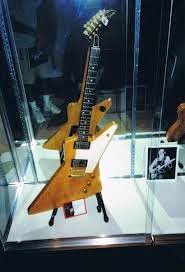I give Dan the credit for writing this article. I just did the editing.
 |
| 1958 Explorer bass at We Buy Guitars |
In late 1958 Roger “Jellyroll” Troy ordered a brand new Gibson Explorer Bass through Dodds Jewerly and Music. But Jellyroll never came back to pick up his bass.
1958 was the year that Gibson introduced the Explorer and the Flying Vee. Both instruments bodies were made of korina wood.
The prototypes were made of mahogany and it was just too heavy, so Gibson opted for the much lighter korina wood. The necks were also made of mahogany.
According to an April 1984 Guitar Player Magazine article Gibson made only three Explorer basses. As mentioned, they had all korina bodies, mahogany necks with an Explorer headstock aka banana, hockey-stick or lady slipper.”
The Explorer bass came with a humbucking pickup that came to be known as a “Mudbucker”. It also had a baritone switch similar to the one found on a Gibson EB-2. This switch activated a large capacitor.
Two of the original Explorers were produced with a natural finish, while the third was sunburst.
 |
| Wayne Bullock with '58 Explorer Bass and Lonnie Mack with '58 Flying Vee |
It was Cincinnati musician Wayne Bullock that finally purchased the bass from Dodds Music and in 1962 he was playing it in the same group in which Lonnie Mack was the guitarist. It is rumored that Jellyroll Troy eventually purchased a 1958 sunburst Explorer bass.
 |
| Author Robb Lawrence |
When Robb Lawrence bought it, the Explorer logo was missing and the scars on the headstock were filled in with putty and painted black. It was worse for wear since it was an actual gigging instrument that had made its rounds to all the greater Cincinnati nightspots.
Lawrence set about restoring the bass to its original splendor. But he lent it out to guys like Chris Squire, John Entwhistle, Jack Bruce and others. These guys loved it. The bass sounded great and was comfortable to play since your hand rested on the elongated back part of the body.
 |
| Randy Jo Hobbs |
It was eventually traded at a store called We Buy Guitars, which was run by Friedman’s brother Richard. The bass spent a few years there.
 |
| Tom Wittrock |
In late 1984 the bass was purchased by a Texas guitar collector named Tony Dukes. He used it in some “fancy” shows with his band “The International Aces.” He also took it to guitar shows.
He nick-named the bass, “Hoss.”
Al Helm, the former manager of Sound Vibrations in Corpus Christi Texas has some knowledge about the bass.
He says, a replica of the bass was featured in a guitar calendar put together by Tony Duke around 1983. Mr. Helms goes on to say that a Cadillac dealer named Byron Goad loved the looks of the bass, but thought the sound was too muddy.
So he ordered an Explorer bass similar to it from the Gibson custom shop. Goad wanted a korina neck on this bass instead of the usual mahogany. He also wanted the ‘lady slipper’ headstock, but Gibson had lost the template. His request was that the tuners be in a row instead of the way they were on the original. Goad finally received it a year after his request. It set him back around $2,000.
Mr. Goad ran into financial difficulty and sold his custom shop Explorer bass. Tony Dukes passed away in 2013. Roger Jellyroll Troy no longer has his Explorer bass. He passed away in 1991.
We do not know what has become of the original Explorer bass or Troy’s sunburst Explorer.
Guitar Afficienado Magazine featured a column in which Rick Neilsen talks about the 1958 Gibson Explorer guitar that he purchased from George Gruhn. He brought the guitar to a Texas Guitar Show and was offered $75,000 cash on the spot.
 |
| Auctioned at Skinners $611K |
He goes on to say that another 1963 Explorer guitar sold for $611,000.
 |
| Clapton's Explorer |
That guitar sold for $134,500.
 |
| Tony Dukes |
Since only three Explorer bass guitars were built in 1958, can you imagine what price they would command?
Unfortunately there are no videos with the 1958 Gibson Explorer Bass. Even more unfortunate is the fact no one knows what happened to the Explorer bass known as "Hoss".
So here a few videos that go along with the article.
The first is Dan Schear (who provided all the information about the 1958 Explorer Bass) sitting in with the Gradual Taylor Band in 1999.
This next one is the original Lonnie Mack recording of Wham with Wayne Bullock on bass.
Get your guitars out and wail along with Lonnie!











Tidak ada komentar:
Posting Komentar